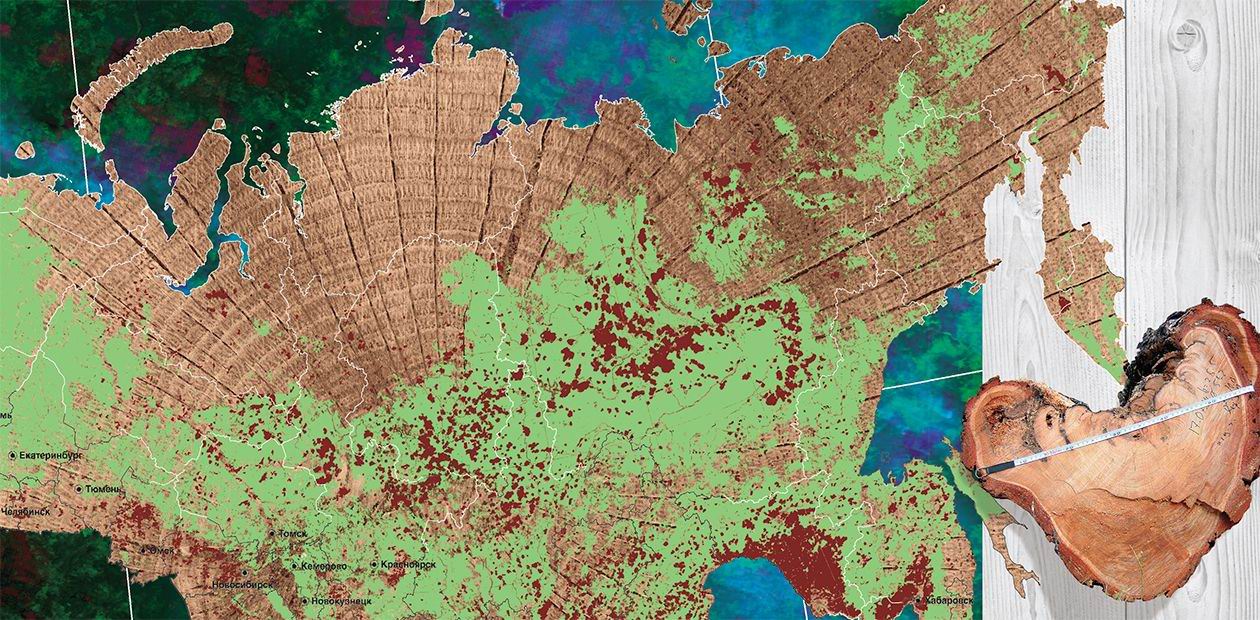Wildfires and Burns of Siberian Taiga
“Black skies,” a smoky “fog” with a distinct smell of burning—this is what people living in Siberia remember of the summer of 2019. That year, the area of fire-engulfed taiga had exceeded, as early as by mid-August, five million hectares, and the smoke from the forest fires reached as far as the Urals and Kazakhstan... By no means always do burnt woodlands recover themselves. Nonetheless, scientists name larch and pine—the northern taiga dominants—as fire-loving trees. So, here comes a paradox: if these forests do not burn, they will not grow
Forest fires have always been around in Siberia, but their frequency and area have increased in the 21st century: in some years, the areas traversed by flame reached 10 to 12 million hectares. Catastrophic fires like that did occur in the past (in 1915, e. g., fires in Siberian taiga burned 12 million hectares) but much less frequently.
Even a cursory look at a map of the forest areas traversed by flame suggests that in the last decade alone, the northern taiga has burnt out by half, and in the near future we risk losing the Siberian forests altogether. However, we should draw a distinction between “areas traversed by flame” and dead forest stands because the consequences depend on the type of vegetation cover as well as the type and intensity of fire.
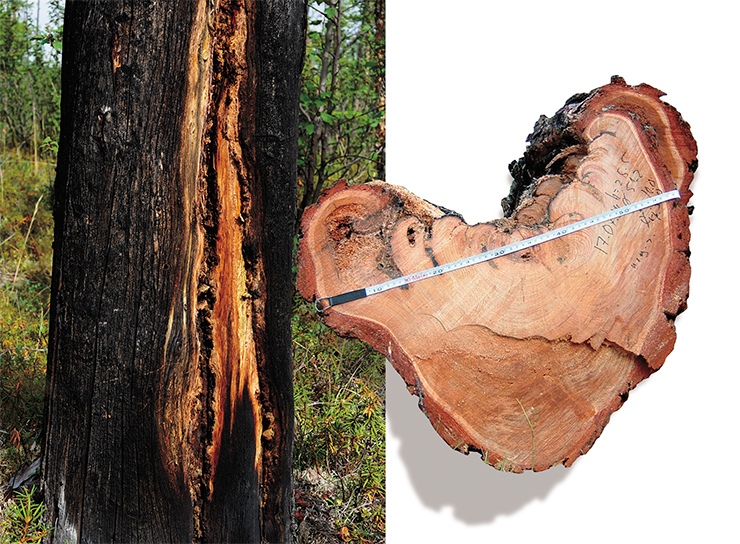
In the United States, the annual area of wildfires has quadrupled over the past 50 years. The forests of Alaska burn regularly—for example, in 2019, wildfires spread over an area of more than 1 million hectares, and a dense smog blanket hovered over Anchorage throughout July. Of course, it is not only northern forests that burn. In the warm California, 800 000 hectares of forests burned down in 2018—despite the extensive personnel and technical support of the firefighter force.
In 2019, extreme wildfires were observed not only in Siberia but also in the tropical Amazonia. In the same year, catastrophic fires destroyed 12 million hectares of Australian bushlands. Warming has brought fires even to the Greenland tundra
In crown fires, which jump along treetops, trees inevitably die. However, during low-intensity ground fires, especially in pine and larch forests, the forest stand usually experiences no considerable destruction. In reality, up to a half of all the forests affected by flame do not die (Bartalev et al., 2015).
Where do wildfires come from?
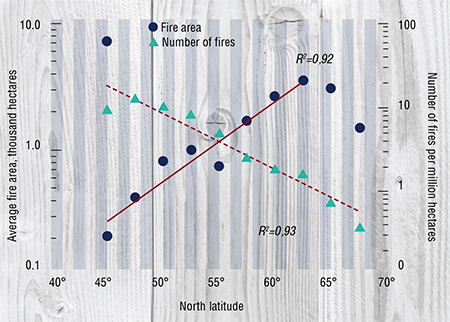 Pyrologists postulate the existence of a “forest fire triad”, i. e., the presence of combustible forest fuel, the “maturity of these materials (readiness for ignition, which depends on weather), and fire ignition source. In the case of the absence of any of these components, wildfire is not possible.
Pyrologists postulate the existence of a “forest fire triad”, i. e., the presence of combustible forest fuel, the “maturity of these materials (readiness for ignition, which depends on weather), and fire ignition source. In the case of the absence of any of these components, wildfire is not possible.
Taiga always provides plenty of combustible materials. Their readiness for ignition, as well as the speed and type of the resulting fire, depends on precipitation, air temperature and humidity, wind, the vegetation type, and terrain features.
In forests at middle latitudes, where most of the population lives, more than 80 % of fires are caused by the so-called human factor. The further to the north, where the population density decreases (in Evenkia, e. g., it is 0.03 people per km2), the lower the likelihood of fires resulting from human negligence. Importantly, indigenous northerners have traditionally been treating forests with care; they know and respect the laws of taiga.
There are three types of wildfires: surface fires, crown fires, and peat fires. Most of wildfires (over 95 %) are ground ones, which spread over the forest floor, litter, and lower tiers of vegetation. By the speed of spreading and the pattern of combustion, they are classified into runaway running and sustained fires. The former commonly occur in early spring, when only the upper layers of forest floor, dead grass, and litter achieve fire maturity. These wildfires usually cause no damage to trees; however, in young coniferous forests, they may transform into crown fires. Stable ground fires occur mainly in summer and fall. They cause the death of ground cover and undergrowth and damage the roots and lower parts of tree trunks. On peat soils, they can transform into peat fires, and in young stands and multi-tiered plantations, they can transform into crown fires.A crown fire captures the entire forest canopy. A surface fire can transform into a crown one due to the closeness of the tree canopy and the presence of dense coniferous undergrowth. Crown fires occur in summer and fall during strong winds. The fire spreads over the canopy very quickly, making leaps at speeds of 100 m per min or more
At high latitudes, the main source of ignition (up to 90 % of cases) is lightning strikes, especially during dry thunderstorms with minimal precipitation, which occur at high temperatures and low relative humidity. Another factor that facilitates lightning-strike fires is a jump in electrical conductivity at the boundary of thawed soil with permafrost, which causes a concentrated release of energy in a narrow surface layer, thus increasing the likelihood of a fire. Incidentally, climate warming entails an increase in the frequency of lightning strikes by 10—12 % per degree (Romps et al., 2014).
As we move further into high latitudes, the level of insolation decreases, reducing the amount of heat for combustible forest fuel to become dry enough so that they can ignite from a lightning strike or a spark from a campfire, and hence the shorter the wildfire season.
On the one hand, this entails a decrease in the number of fires and, accordingly, a lengthening of the interval between the fires (fire return interval). In the taiga between the Angara and Podkamennaya Tunguska rivers, this interval is about 80 years, but at the northern boundary of larch growth, it is as long as 300 years. On the other hand, as we move further into high latitudes, the sizes of burnt areas increase — because of a more extensive supply of combustible forest fue and the lack of effort to extinguish wildfires not threatening human settlements.
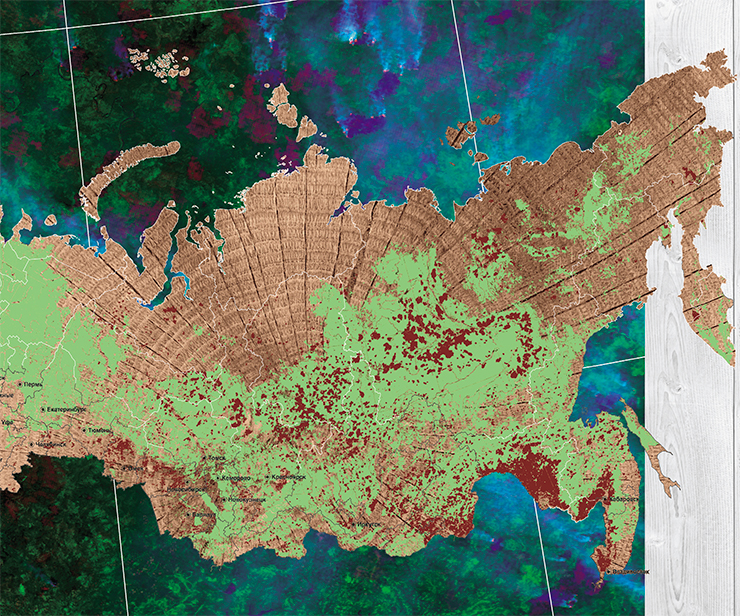
Northern fires have several more distinctive features. So, in the middle latitudes, two peaks exist in the occurrence of fires: the first one in spring and at the beginning of summer and the second one in August–September. In the north, the frequency of fires is limited by the amount of heat required for the maturation of combustible materials; so, the fire occurrence here reaches a maximum in mid-summer.
The emergence and development of fires is closely related to the landscape features. The altitude above sea level has a bearing on precipitation and air temperature, which affect the fire occurrence, as well as on the likelihood of lightning discharges. Fires occur mainly on warmed southern slopes. In the mountainous taiga, the fire edge speed increases sharply (up to an order of magnitude) on steep slopes, bolstered by hot air streams ascending along the slopes.
Like a phoenix from the ashes
Larch, along with birch, deserves to be a symbol of Russia; indeed, larch forests account for over 40 % of Russian woodlands. Moreover, in the permafrost zone, also characterized by a shallow seasonal layer of thawing, Siberian, Daurian, and Cajander larch trees form up to 80 % of taiga forests.
The greatest impact on forests comes from large (S>2000 ha) fires, the area of which can reach of 100 000 to 200 000 hectares. Although the share of these fires does not exceed 8—10 % of all cases, their area makes up 90 % of total annual burnt. Fire intensity depends on the type of forest stand and weather conditions, and in 5—15 % of all cases, one can speak of very strong burningLarch forests growing on permafrost soils stand out in that the layer where the roots can be contained narrows gradually over time (up to 30 cm or less) due to a decrease in the depth of seasonal thawing. The reason lies with the growth of a “pillow” of moss and lichen, an excellent heat insulator. As the permafrost rises, the influx of nutrients decreases, leading to a decrease in the annual growth of trees. The amount of undergrowth also decreases sharply—the light larch seeds hover on the moss layer and cannot reach the soil during germination.
This way larch forests “fall into slumber,” and only forest fires can wake them up. More than half of all fires in Siberia occur precisely in those forests where the larch tree dominates. In addition, most of this zone receives little precipitation (often less than 300 mm per year) and often experiences prolonged droughts. The powerful Siberian anticyclone, with a rainless period lasting a month or even longer, also contributes to the high fire hazard of larch forests. Fires are also provoked by the growth of mosses and lichens, which, when dried, become an excellent conductor of combustion.
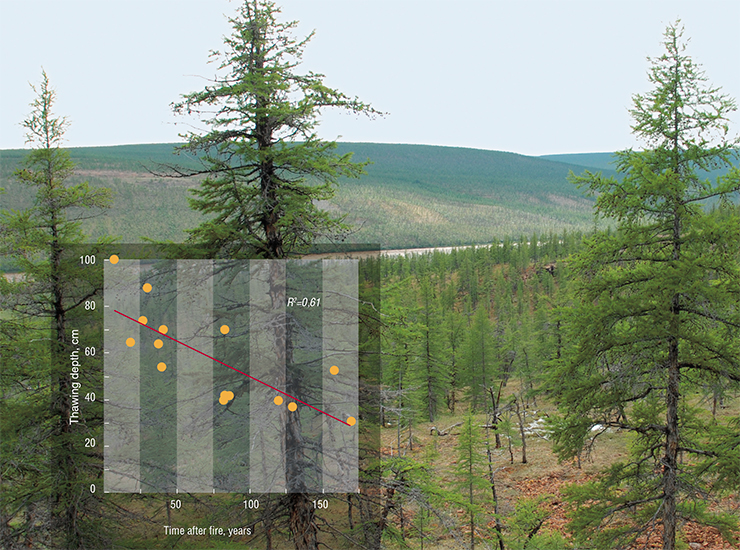
The most important consequence of these fires is the improvement of environmental conditions for the renewal of larches. The seeds come from the surviving trees on the burnt out areas—even in stand-replacing fires, some of the larches may survive because of terrain features and humidity variations. And even if a larch forest dies out completely but the seeds have had time to ripen (which is possible for autumn fires), then the burnt out area is abundantly sown with seeds which fallen from cones. Larch seeds, light and winged, can also be brought from undamaged stands onto burnt out areas over the snow by wind and melt water.
These seeds give rise to abundant, rapidly growing regeneration since the soil on burnt out areas is enriched with nitrogen, phosphorus, and other nutrients and is characterized by a better drainage and aeration as well as a greater depth of seasonal thawing. Moreover, the light regime on burnt out areas improves drastically because of the death of the maternal canopy and the burning out of the living ground cover, and this change means a lot for this light-loving species. Thus, the trees that survive the fire also show a marked increase in their growth.
Since larch is so fond of light, it recovers very poorly under a dense closed canopy. It is the longevity of this species that helps it to survive in mixed forest stands—in southern taiga, its age reaches 600 years, and northern taiga larches can live as long as 1000 years! Other conifers live a shorter life with the age limits of 300—350 years for spruce, 200—250 for fir, and 400—500 years for pine and cedarThus, fires contribute to the renewal and rejuvenation of the larch forest ecosystem. Foresters define larch as a pyrophytic, or fire-loving, species since forest fires support the larch’s dominance, especially in permafrost conditions. By the way, along with larch, burnt out areas in the permafrost zone are partially renewed by birch and alder. These species subsist in larch forests as an accompanying element in favorable habitats, e. g., in river floodplains.
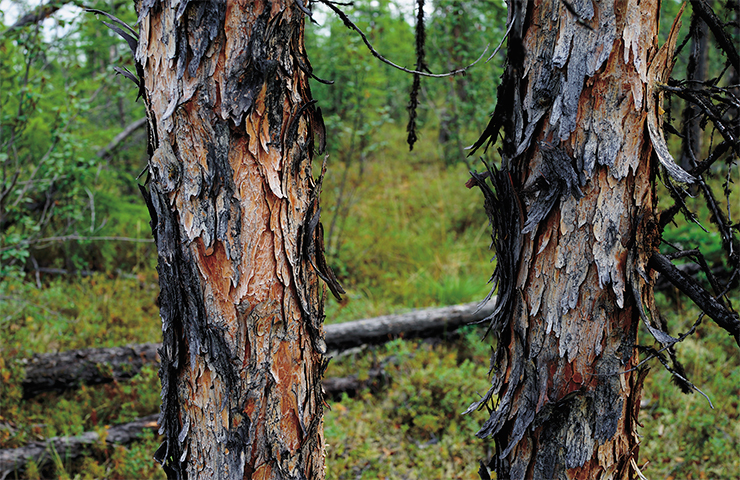
Another fire-loving plant is the Scots pine. In the absence of fires, it is forced out into poorer soils and wetlands by other species, such as spruce. Like larch, pine demands a lot of light and cannot regenerate well under the forest canopy. Both of these species evolved under the conditions of periodic fires, adapting to them and gaining competitive advantages over other breeds.
In satellite images and ground-based surveys, the entire area of northern larch forests appears as a mosaic of forest stands at different stages of recovery after fires. And the question arises: Does it make sense to fight fires everywhere in forests, the very existence of which depends on periodic fires? Are the costs of extinguishing them economically sound, especially in remote, inaccessible areas, where fires threaten neither human lives and homes nor industrial facilities? Eventually, this work will be done by the natural fire-fighting mechanism, i. e., rain-carrying cyclones that arrive to replace the hot weather.
Dark needle conifers burn
Fires cause the greatest damage to dark needle coniferous forests, which are formed by Siberian pine, fir, and spruce. In these forests, fires occur less frequently since these species demand higher humidity; thus, their habitats experience more precipitation than those where the drought-resistant larch and pine grow. Siberian pine (commonly known as cedar), as well as fir, are so hydrophilic that it was called the “tree of fogs.”
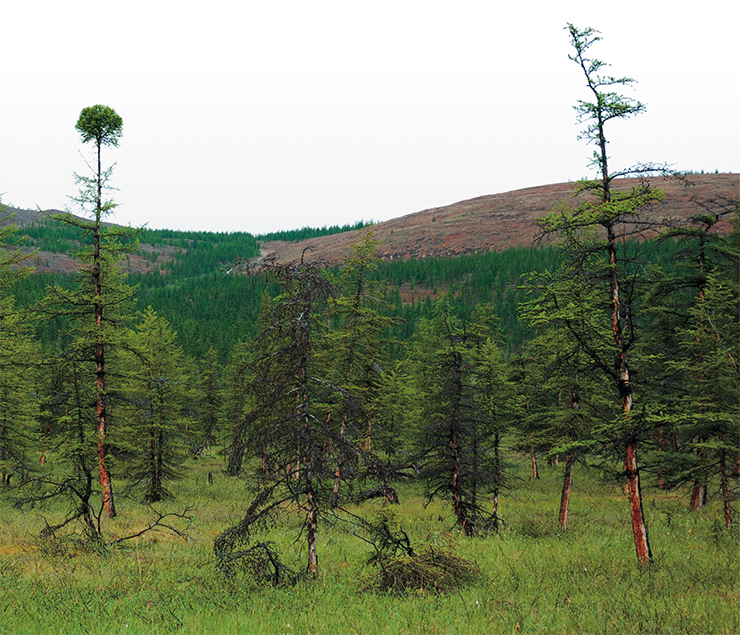
In dry years, however, the areas of fires in these forests reach millions of hectares, as it happened, e. g., in 2010 in Western Siberia. Unlike pine and larch, dark conifers’ trunks have poor crust protection against ground fires, and their dense crowns, which often descend, almost reaching the ground, and are full of essential oils, support the transformation of ground fires into devastating crown ones. The latter spread at such a speed that even the swift-foot forest deer can hardly escape from them.
Burnt out areas in dark coniferous forests usually recover through a change in tree species. Aspen and birch come first, and as they grow and form a canopy, dark needle confers take root underneath since these species, primarily fir and spruce, tolerate shade. Gradually, they penetrate into the upper tier of the forest. Birch and especially aspen are light-loving species and cannot survive under the dense dark-coniferous canopy. Besides, they do not live long—by the age of eighty, most aspen trees decay due to heart rot.
Thus, over a hundred years, the small-leaved species are usually replaced by the indigenous dark conifers. However, a part of the area can long remain under grasses and shrubs as well as aspen or birch. The reason is that the overgrown grass and shrub cover provokes fires (in spring, dry grass provides an excellent combustible material), which destroy the undergrowth of dark conifers. Birch and aspen, in turn, are able to reproduce by root sprouts. It is these habitats that need human help for the recovery of dark coniferous forests.
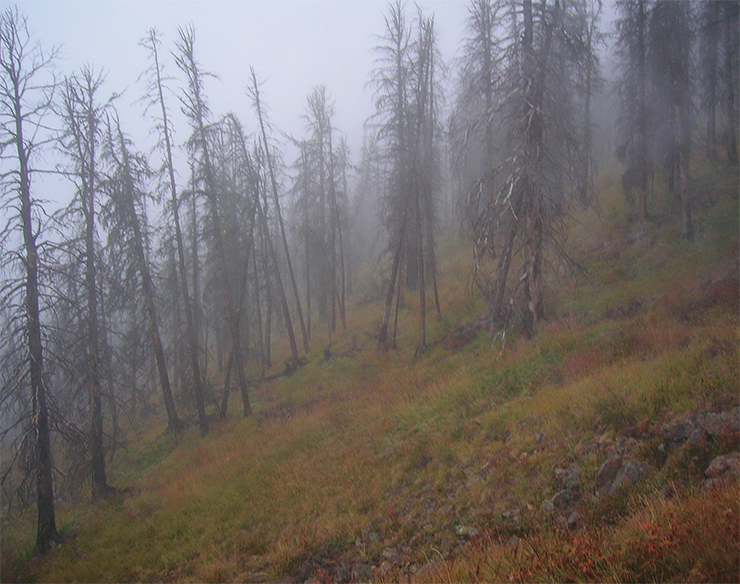
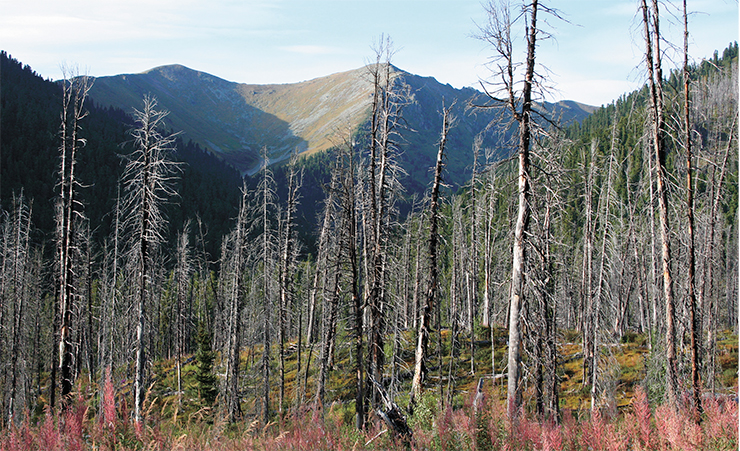
However, the complete suppression of fires creates old and weak “overgrown” stands, which become a food base for bark beetles and other phytopathogens. For example, a while ago the forests on the western coast of North America, which had been saved from fire, were subsequently destroyed by bark beetles, which turned them into deadwood.
FROM THE HISTORY OF FIREFIGHTING One of the world’s first airborne forest firefighting units was established in the Irkutsk region in the early 1930s. Subsequently, until the onset of the perestroika, the number of such units was growing and the area of firefighting and fire control was expanding. In the 1990s, the forest firefighting system as a whole degraded, including a decrease in the number of specialized airborne detachments. For example, the air patrol bases in the settlement of Baikit (Podkamennaya Tunguska river) and in the city of Tura, the capital of Evenkia, have not been restored yet. The restoration and expansion of air patrol bases and the modernization of airfields are now a priority task in order not to repeat the mistakes of the firefighting campaign in 2019, when IL 76 aircraft were carrying tap (!) water to the fire zones 500—600 km from their home-base airportTo avoid catastrophic fires and reduce the level of fire hazard, pyrologists suggest organizing preventive fires. These controlled fires burn forest trash (deadwood, litter, etc.), which accumulates to become fuel for a ground fire and provoke its transformation into a devastating crown fire.
The method of controlled fires requires high professionalism and can only be applied locally. First, it is costly because one needs to prepare the area, cut glades around it, and then monitor the development of the fire. Second, it is risky because one needs to be very precise about choosing the time and weather conditions so that a change in wind direction or intensity would not allow the fire to escape the control zone and/or cause a crown fire. Such an event happened, e. g., in the early 2000s in the United States, when an out-of-control fire headed towards the well-known Los Alamos Nuclear Center in California.
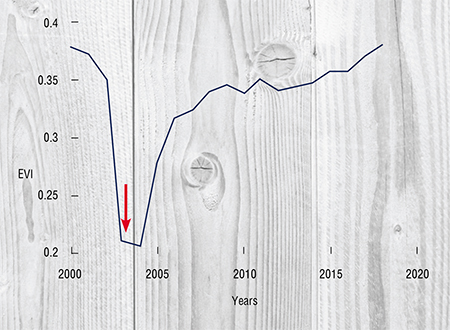 According to pyrologists truism, forests have always burnt and always will. In the future, according to forecasts, forests will burn even more often and on ever-increasing areas. The warming in Siberia, like in the entire boreal zone, is developing twice as fast as on the planet as a whole. This process will inevitably lead to increased weather anomalies and a lengthening of the fire hazard period, which means an increase in the frequency, intensity, and area of fires.
According to pyrologists truism, forests have always burnt and always will. In the future, according to forecasts, forests will burn even more often and on ever-increasing areas. The warming in Siberia, like in the entire boreal zone, is developing twice as fast as on the planet as a whole. This process will inevitably lead to increased weather anomalies and a lengthening of the fire hazard period, which means an increase in the frequency, intensity, and area of fires.
In the future, one expects a spatial shift in terrestrial ecosystems, leading to changes in the indicators of fire occurrence in Siberian forests. In the southern taiga, they will manifest itself primarily in the reduction of intervals between fires; in the north, these changes will intensify the variegation of fire regimes.
In general, the fire situation in boreal forests will inevitably worsen in the coming decades. Our Canadian colleagues also warn about this, pointing out the necessity to accept that the area of wildfires will more than double in the future, which will entail an increase in the smoke content of the atmosphere (Flannigan, 2020). Wildfires emissions now covers not only Canadian forests but also reaches Vancouver, Montreal, and New York.
The changing fire regimes necessitate the development of a new firefighting strategy. It is known that the complete suppression of wildfires leads to the accumulation of combustible materials in forest stands, provoking catastrophic fires, an effect that pyrologists call the fire paradox. Meanwhile, the diversity of forest landscapes also decreases.
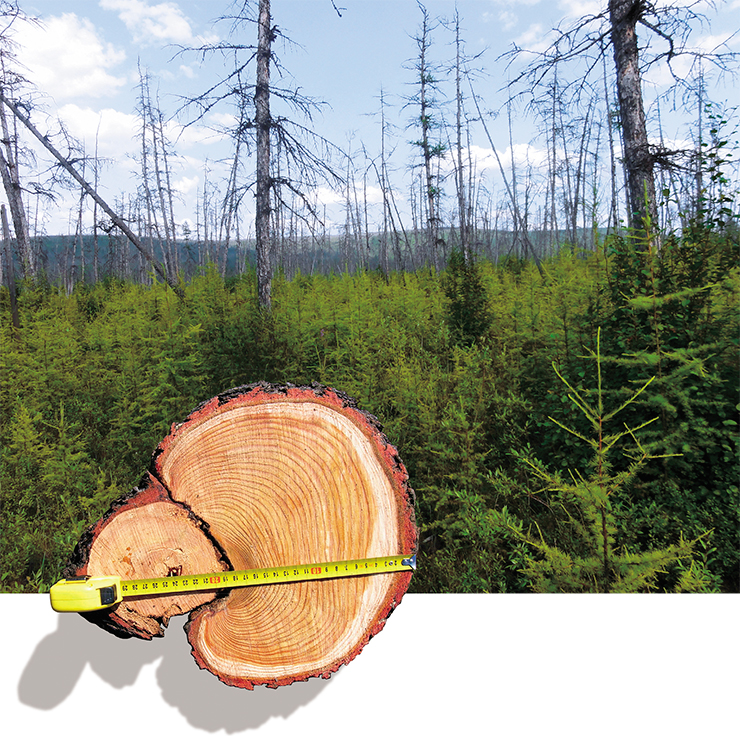
It is wildfires themselves that can help in firefighting since, paradoxically, they not only reduce the probability of vast intensive fires but also facilitate the recovery of forest ecosystems—the so-called double fire paradox. Taken separately, no other means (controlled fires, removal of combustible materials) can support the existence of the vast northern forests (Tymstra et al., 2020).
BOREAL FORESTS AS A CARBON SINK Northern forests are of special value—they serve as one of the main sources of oxygen on our planet and a sink, or absorber, for carbon dioxide. What impact will the climate change and the ensuing increase in wildfire occurrence have on this role of northern taiga, including larch forests?It turns out that an increase in wildfire occurrence may transform forests from the sink into a source of carbon dioxide. This phenomenon was recorded in some years of extreme burning in the taiga forests of Canada (IPCC, 2014).
However, the warming not only leads to an increase in wildfire occurrence—it also lengthens the vegetative season and causes an increase in the annual growth of trees, as confirmed by an increase in the gross primary productivity of larch forests in most of their range. Therefore, a scenario is likely in the future, whereby northern forests will be playing a bigger role in carbon sequestration and mitigation of anthropogenic impact on the biosphere.
In addition, as a result of the warming, larch, like several other tree and shrub species, is now spreading into the polar tundra zone and, according to forecasts, should reach the coast of the Arctic Ocean
Given the current climate warming, we need to accept the fact that the damage from wildfires will rising and the possibility of their complete suppression will decrease. In this regard, Canadian scientists propose to change the existing paradigm and allow for more wildfires within the vast forest landscapes. Instead of complete suppression, they recommend monitoring wildfires and taking action to extinguish them only when they pose a threat to population and specially protected areas. Such a firefighting strategy, based on acceptable risks of possible damage, has been implemented in the province of Saskatchewan in southern Canada.
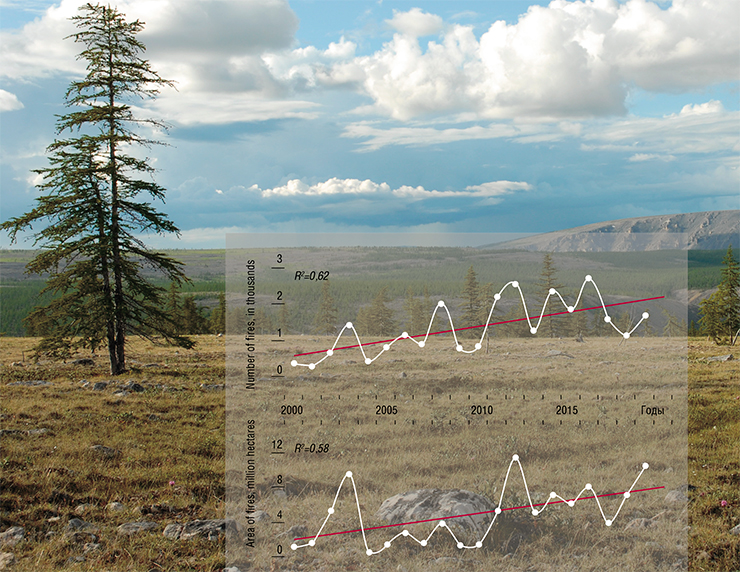
Similar ideas were proposed and partly applied in practice by Russian scientists and engineers. However, the changing climate necessitates considerable changes in the strategy and tactics of wildfires (fighting?) in our forests, including adequate zoning of forest areas by firefighting priority. It is necessary to identify priority areas and focus on the protection of those with high social, natural, and economic value, taking into account the importance of endangered forests, including their off-market value, the presence of industrial infrastructure and settlements, the impact of smoke on human health, and the cost of firefighting. Particular attention should be paid to improving the firefighting techniques and strengthening the firefighters’ technology base, including the development of a fleet of tank aircraft and expanding the resources of the aircraft forest protection network.
However, so far this view on the issue of the expanding wildfires in forests and the risks of increased losses from forest fires does not strike a chord with politicians as well as the general public.
References
Bartalev S. A., Stytsenko F. V., Egorov V. A. et al. Sputnikovaya otsenka gibeli lesov Rossii ot pozharov // Lesovedenie. 2015. N. 2. P. 83–94 [in Russian].
Kharuk V. I., Ponomarev E. I. Spatiotemporal Characteristics of Wildfire Frequency and Relative Area Burned in Larch-dominated Forests of Central Siberia // Russian Journal of Ecology. 2017. V. 48. N. 6. P. 507–512.
Kharuk V. I., Ranson K. J., Dvinskaya M. L. Wildfires dynamic in the larch dominance zone // Geophys. Res. Lett. 2008. V. 35. ARTN L01402.
Kharuk V. I., Dvinskaya M. L., Petrov I. A. et al. Larch Forests of Middle Siberia: Long-Term Trends in Fire Return Intervals // Regional Environmental Change. 2016. V. 16. P. 2389–2397.
Krylov A., McCarty J. L., Potapov P. et al. Remote sensing estimates of stand-replacement fires in Russia, 2002–2011 // Env. Res. Lett. 2014. V. 9. N. 105007. P. 1–8.
de Groot W. J., Flannigan M. D., Cantin A. S. Climate change impacts on future boreal fire regimes // For Ecol Manage. 2013. N. 294. P. 35–44.
Wotton B. M., Flannigan M. D., Marshall G. A. Potential climate change impacts on fire intensity and key wildfire suppression thresholds in Canada // Environ Res Lett. 2017. V. 12(9).
Tymstra C., Stocks B., Cai X. et al. Wildfire management in Canada: Review, challenges and opportunities // Progress in Disaster Science. 2020. V 5. 10004.
Romps D., Seeley J., Vollaro D. et al. Projected increase in lightning strikes in the United States due to global warming // Science. 2014. V. 346(6211). P. 851–854.
This work was supported by the Russian Foundation for Basic Research (RFBR), project 18-05-00432, and jointly by the Krasnoyarsk Krai Science Foundation and RFBR, project 18-41-242003
This article uses photos by Vyacheslav Kharuk


